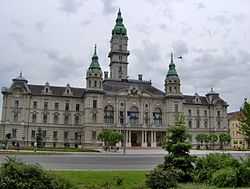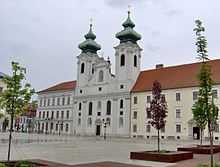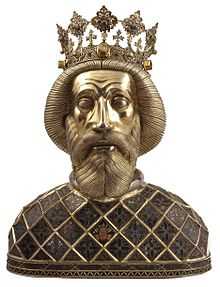Győr
Coordinates: 47°41′03″N 17°38′04″E / 47.68417°N 17.63444°E
| Győr | ||
|---|---|---|
| City | ||
| ||
 Győr | ||
| Coordinates: 47°41′03″N 17°38′06″E / 47.68403°N 17.63507°E | ||
| Country |
| |
| County |
| |
| Government | ||
| • Mayor | Zsolt Borkai | |
| Area | ||
| • City | 174.61 km2 (67.42 sq mi) | |
| Elevation | 108 m (354 ft) | |
| Population (2011) | ||
| • City |
131,267 | |
| • Rank | 6th | |
| • Density | 730.71/km2 (1,892.5/sq mi) | |
| • Urban | 183 407 | |
| • Metro | 357 264 | |
| • Demonym | győri | |
| Time zone | CET (UTC+1) | |
| • Summer (DST) | CEST (UTC+2) | |
| Postal code | 9000 - 9030 | |
| Area code(s) | 96 | |
| Website | www.gyor.hu | |
Győr (Hungarian pronunciation: [ˈɟøːr] (![]() ); German: Raab, Slovak: Ráb, names in other languages) is the most important city of northwest Hungary, the capital of Győr-Moson-Sopron county and Western Transdanubia region, and — halfway between Budapest and Vienna — situated on one of the important roads of Central Europe. The city is the sixth largest in Hungary, and one of the seven main regional centres of the country.
); German: Raab, Slovak: Ráb, names in other languages) is the most important city of northwest Hungary, the capital of Győr-Moson-Sopron county and Western Transdanubia region, and — halfway between Budapest and Vienna — situated on one of the important roads of Central Europe. The city is the sixth largest in Hungary, and one of the seven main regional centres of the country.
History
The area along the Danube River has been inhabited by varying cultures since ancient times. The first large settlement dates back to the 5th century BCE; the inhabitants were Celts. They called the town Arrabona, a name that was used for eight centuries; its shortened form is still used as the German (Raab) and Slovak (Ráb) names of the city.
Roman merchants moved to Arrabona during the 1st century BCE. Around 10 CE, the Roman army occupied the northern part of Western Hungary, which they called Pannonia. Although the Roman Empire abandoned the area in the 4th century due to constant attacks by the tribes living to the east, the town remained inhabited.
Around 500 the territory was settled by Slavs, in 547 by the Lombards, and in 568-c.800 by the Avars, at that time under Frankish and Slavic influence. Between 880 and 894, it was part of Great Moravia, and then briefly under East Frankish dominance.



The Magyars occupied the town around 900 and fortified the abandoned Roman fortress. Stephen I, the first king of Hungary, founded an episcopate there. The town received its Hungarian name Győr. The Hungarians lived in tents, later in cottages, in what is now the southeastern part of the city centre. The town was affected by all the trials and tribulations of the history of Hungary: it was occupied by Mongols during the Mongol invasion of Hungary (1241–1242) and then was destroyed by the Czech army in 1271.
After the disastrous battle of Mohács, Baron Tamás Nádasdy and Count György Cseszneky occupied the town for King Ferdinand I while John Zápolya also was attempting to annex it. During the Ottoman occupation of present-day central and eastern Hungary[1] (1541 - late 17th century), Győr's commander Kristóf Lamberg thought it would be futile to try to defend the town from the Turkish army. He burned down the town and the Turkish forces found nothing but blackened ruins, hence the Turkish name for Győr, Yanık kale ("burnt city").
During rebuilding, the town was surrounded with a castle and a city wall, designed by the leading Italian builders of the era. The town changed in character during these years, with many new buildings built in Renaissance style, but the main square and the grid of streets remained.
In 1594, after the death of Count János Cseszneky, captain of Hungarian foot-soldiers, the Ottoman army occupied the castle and the town. In 1598 the Hungarian and Austrian army took control of it again and occupied it. During the Turkish occupation the city was called Yanık.
In 1683, the Turks returned briefly, only to leave after being defeated in the Battle of Vienna.
During the following centuries, the town became prosperous. In 1743 Győr was elevated to free royal town status by Maria Theresa. The religious orders of Jesuits and Carmelites) settled there, building schools, churches, a hospital and a monastery.
In June 14, 1809, this was the site of the Battle of Győr (Battle of Raab), where the Grand Armee of Napoleon defeated the Hungarian noble rebels and Austrian corps. Napoleon occupied the castle and had some of its walls blown up. The leaders of the town soon realized that the old ramparts were not useful any more. Most of the ramparts were destroyed, allowing the town to expand.
In the mid-19th century, Győr's role in trade grew as steamship traffic on the River Danube began. The town lost its importance in trade when the railway line between Budapest and Kanizsa superseded river traffic after 1861. The town leaders compensated for this loss with industrialisation. The town prospered till World War II but, during the war, several buildings were destroyed.
During World War II, after the Nazis took control in Hungary, they organized the deportation of the Jews. They comprised 12.6% of the Győr population according to the 1910 census. On May 13, 1944, the Nazis ordered them into a ghetto. Two trains were loaded to transport the Jews of the town and the neighboring villages to Auschwitz on June 11 and on June 14. Altogether, 5,635 people were deported on these two days. Nearly all were killed in the extermination camp or along the way. Some exempted Jews were left behind, but they were massacred on March 26, 1945, just hours before liberation by the Allies.
| Historical population | ||
|---|---|---|
| Year | Pop. | ±% |
| 1870 | 21,767 | — |
| 1890 | 28,175 | +29.4% |
| 1900 | 38,094 | +35.2% |
| 1910 | 45,083 | +18.3% |
| 1920 | 51,268 | +13.7% |
| 1930 | 52,456 | +2.3% |
| 1941 | 58,431 | +11.4% |
| 1949 | 58,431 | +0.0% |
| 1960 | 72,060 | +23.3% |
| 1970 | 102,600 | +42.4% |
| 1980 | 124,147 | +21.0% |
| 1990 | 129,331 | +4.2% |
| 2001 | 129,412 | +0.1% |
| 2011 | 129,527 | +0.1% |
The 1950s and 60s brought more change: only big blocks of flats were built, and the old historical buildings were not given care or attention. In the 1970s the reconstruction of the city centre began; old buildings were restored and reconstructed. In 1989 Győr won the European award for the protection of monuments.[citation needed]
A 100-year-old Raba factory on the River Danube close to the historical centre is to be replaced by a new community called Városrét. The mixed-use community will have residential and commercial space as well as schools, clinics and parks.
The city's main theatre is the National Theatre of Győr, finished in 1978. It features large ceramic ornaments made by Victor Vasarely.
The city has several historical documents, for example the castle, and the Lutheran Evangelic church.
Climate
| Győr | ||||||||||||||||||||||||||||||||||||||||||||||||||||||||||||
|---|---|---|---|---|---|---|---|---|---|---|---|---|---|---|---|---|---|---|---|---|---|---|---|---|---|---|---|---|---|---|---|---|---|---|---|---|---|---|---|---|---|---|---|---|---|---|---|---|---|---|---|---|---|---|---|---|---|---|---|---|
| Climate chart (explanation) | ||||||||||||||||||||||||||||||||||||||||||||||||||||||||||||
| ||||||||||||||||||||||||||||||||||||||||||||||||||||||||||||
| ||||||||||||||||||||||||||||||||||||||||||||||||||||||||||||
| Climate data for Győr | |||||||||||||
|---|---|---|---|---|---|---|---|---|---|---|---|---|---|
| Month | Jan | Feb | Mar | Apr | May | Jun | Jul | Aug | Sep | Oct | Nov | Dec | Year |
| Average high °C (°F) | 1.9 (35.4) |
4.6 (40.3) |
10.2 (50.4) |
16.0 (60.8) |
21.1 (70) |
24.0 (75.2) |
26.2 (79.2) |
25.6 (78.1) |
21.6 (70.9) |
15.9 (60.6) |
8.3 (46.9) |
3.3 (37.9) |
14.89 (58.81) |
| Average low °C (°F) | −4.0 (24.8) |
−2.0 (28.4) |
1.4 (34.5) |
5.5 (41.9) |
9.9 (49.8) |
13.1 (55.6) |
14.4 (57.9) |
14.1 (57.4) |
10.8 (51.4) |
5.9 (42.6) |
1.9 (35.4) |
−1.9 (28.6) |
5.76 (42.36) |
| Precipitation mm (inches) | 32 (1.26) |
33 (1.3) |
28 (1.1) |
38 (1.5) |
55 (2.17) |
64 (2.52) |
53 (2.09) |
65 (2.56) |
38 (1.5) |
35 (1.38) |
53 (2.09) |
38 (1.5) |
532 (20.97) |
| Avg. precipitation days | 7 | 6 | 7 | 7 | 8 | 9 | 7 | 7 | 6 | 5 | 8 | 7 | 84 |
| Source: HKO | |||||||||||||
Main sights
The ancient core of the city is Káptalan Hill at the confluence of three rivers: the Danube, Rába and Rábca. Püspökvár, the residence of Győr’s bishops, can be easily recognised by its incomplete tower. Győr’s oldest buildings are the 13th-century dwelling tower and the 15th-century Gothic Dóczy Chapel. The Cathedral, originally in Romanesque style, was rebuilt in Gothic and Baroque style.
Other sights include:
- Town Hall
- Benedictine church of St. Ignatius of Loyola
- Carmelite church
- Museum of Roman Archaeology
The Pannonhalma Archabbey is located some 20 kilometres (12 miles) outside the town.
Economy
Audi AG subsidiary company Audi Hungaria Motor Kft. has a large factory in Győr, where the Audi TT sports car, the A3 Cabriolet,[2] A3 Limousine[3] and many engines (1,913,053 engines in 2007) are built. The factory opened in 1994, at first producing inline-four engines for the Audi marque. Business then grew to assembling the Audi TT Coupé and TT Roadster. Eventually, V6 and V8 engines were also included, and after the acquisition of Automobili Lamborghini S.p.A., Audi then began to build V10 engines. The V10s for Audi vehicles are fully assembled here, but only the cylinder blocks for the Lamborghini V10.[4] Engines are also supplied to other Volkswagen Group marques, but over 90% of Audi vehicle engines are made here.[5]
Notable people
- Johann Georg Albrechtsberger, composer
- Tamás Bakócz, archbishop
- Miklós Borsos, sculptor
- György Cseszneky, count, castellan
- János Cseszneky, count, infantry commander
- Josef Dobrovský
- Erzsébet Galgóczi, writer
- Anita Görbicz, handball player
- Izidor Guzmics
- Stanley Jaki
- Ányos Jedlik
- Gyula König
- Margit Kovács
- Raimondo Montecuccoli
- Desiderius Orban, painter, one of The Eight, who emigrated in 1939 to Australia
- Zoli Pitman
- Antal Pusztai
- Alexander Raab, pianist
- Hans Richter, conductor
- Frigyes Riesz, mathematician
- Marcel Riesz, mathematician
- Samuel Aba of Hungary, king
- Ľudovít Štúr
- József Szlávy, prime minister of Hungary
- Tibor Varga
- Garcilaso de la Vega, poet
- Emil Zuckerkandl
Sports
Győr is the home of the Győri ETO Sport Club, which has many sport divisions. The most popular sport in the city is handball, with the Győri ETO KC being the city's main team. Győri ETO FC is a football team.
International relations
Twin towns — Sister cities
| City | Region | Country |
|---|---|---|
| Kuopio | |
|
| Erfurt | |
|
| Sindelfingen | |
|
| Ingolstadt | |
|
| Colmar | |
|
| Bryansk | |
|
| Braşov | |
|
| Nazareth Illit | |
|
| Wuhan | |
|
| Poznań | |
|
| Montevideo | |
|
Trivia
In December 2011, the composer Andi Coryn released a song named "Győr."[9]
References
Notes
- ↑ "Royal Hungary (historical region, Hungary) -". Britannica Online Encyclopedia. Retrieved 2011-09-16.
- ↑ "Start of production and world premiere for the Audi A3 Cabriolet in Hungary". Volkswagen AG. 30 November 2007. Retrieved 30 August 2009.
- ↑ "World Industrial Reporter – Audi Hungaria Celebrates Start of Production of A3 Limousine". © 2013 Thomas Publishing Company. 2013-06-13. Retrieved 2013-07-17.
- ↑ "Lamborghini Cars full specifications - First spyshots of the Lamborghini L140 model". LamboCars.com. Archived from the original on 2005-04-18. Retrieved 30 August 2009.
- ↑ "Audi ups Hungarian output". BBJ.hu. Archived from the original on 2008-06-21. Retrieved 2 January 2012.
- ↑ "www.gyor.hu - Twincities of Győr". Admin.gyor.hu. Retrieved 2011-03-10.
- ↑ "Официальный сайт города Брянска" (in Russian). Admin.bryansk.ru. Archived from the original on February 14, 2008. Retrieved 2009-07-08.
- ↑ "Poznań - Miasta partnerskie". 1998–2013 Urząd Miasta Poznania (in Polish). City of Poznań. Archived from the original on 2013-09-23. Retrieved 2013-12-11.
- ↑ "Andi Coryn's official website".
External links
- Official site (English) (Hungarian) (German)
-
 Győr travel guide from Wikivoyage
Győr travel guide from Wikivoyage - Aerial photography: Győr
- Aerial view of Gyor by Volkan Yuksel
- Győr at funiq.hu (English)
| ||||||||||
| ||||||||||||||||||||
| Wikimedia Commons has media related to Győr. |



